Abstract
Soil moisture is a critical parameter that significantly impacts the global energy balance, including the hydrologic cycle, land–atmosphere interactions, soil evaporation, and plant growth. Currently, soil moisture is typically measured by installing sensors in the ground or through satellite remote sensing, with data retrieval facilitated by reanalysis models such as the European Centre for Medium-Range Weather Forecasts (ECMWF) Reanalysis 5 (ERA5) and the Global Land Data Assimilation System (GLDAS). However, the suitability of these methods for capturing local-scale variabilities is insufficiently validated, particularly in regions like South Korea, where land surfaces are highly complex and heterogeneous. In contrast, artificial intelligence (AI) approaches have shown promising potential for soil moisture retrieval at the local scale but have rarely demonstrated substantial products for spatially continuous grids. This paper presents the retrieval of daily soil moisture (SM) over a 500 m grid for croplands in South Korea using random forest (RF) and automated machine learning (AutoML) models, leveraging satellite images and meteorological data. In a blind test conducted for the years 2013–2019, the AutoML-based SM model demonstrated optimal performance, achieving a root mean square error of 2.713% and a correlation coefficient of 0.940. Furthermore, the performance of the AutoML model remained consistent across all the years and months, as well as under extreme weather conditions, indicating its reliability and stability. Comparing the soil moisture data derived from our AutoML model with the reanalysis data from sources such as the European Space Agency Climate Change Initiative (ESA CCI), GLDAS, the Local Data Assimilation and Prediction System (LDAPS), and ERA5 for the South Korea region reveals that our AutoML model provides a much better representation. These experiments confirm the feasibility of AutoML-based SM retrieval, particularly for local agrometeorological applications in regions with heterogeneous land surfaces like South Korea.
1. Introduction
Although soil moisture constitutes a quantitatively small part of hydrological systems, it is a crucial variable that affects the global energy balance, including the hydrologic cycle, land–atmosphere interactions, soil evaporation, and plant growth []. Recently, several drought indices have been developed to monitor the increasing incidence of droughts due to extreme weather conditions, with soil moisture-based indices being particularly useful for tracking meteorological and agricultural droughts. A lack of soil moisture can impact crop productivity and the availability and transport of soil nutrients, and ultimately lead to decreased crop yields []. Therefore, accurate soil moisture observation is one of the most critical topics in the study of hydrology, water resources, and agriculture.
In general, in situ soil moisture measurements are the most reliable method. However, the installation and maintenance of these measurement systems are costly, and their spatial coverage is sparse [,,]. In contrast, satellite observations offer continuous spatiotemporal coverage on a global scale, leading to numerous studies aimed at producing soil moisture products using satellite data. Satellite-based soil moisture observations primarily rely on passive microwave sensors, such as the Advanced Scatterometer (ASCAT), Meteorological Operational Satellite-A (MetOp-A), Advanced Microwave Scanning Radiometer-Earth Observing System (AMSR-E), AMSR2, Soil Moisture Ocean Salinity (SMOS), and Feng-Yun 3C (FY3C). However, passive microwave sensor-based soil moisture data typically have a low spatial resolution of 10 to 25 km, making them less suitable for local-scale applications. Additionally, these satellite sensors observe soil moisture at a shallow depth of about 5 cm from the soil surface, whereas in situ data collected by time-domain reflectometry (TDR) sensors measure soil moisture at depths of 10 to 30 cm, accounting for the root depth of vegetation. This discrepancy results in differences between satellite observations and in situ measurements, and the accuracy of soil moisture estimates from passive microwave sensors remains unsatisfactory. On the other hand, soil moisture observations using Synthetic Aperture Radar (SAR) or active microwave sensors offer several advantages. SAR sensors provide high-resolution images with a spatial resolution of less than 100 m and are not affected by weather conditions. However, the primary disadvantage of SAR is its low temporal resolution, often exceeding ten days.
In addition, soil moisture can be extracted from various reanalysis datasets, including the European Centre for Medium-Range Weather Forecasts (ECMWF) Reanalysis 5 (ERA5), the Global Land Data Assimilation System (GLDAS), the North American Land Data Assimilation System (NLDAS), the Modern-Era Retrospective Analysis for Research and Applications (MERRA) by the National Aeronautics and Space Administration (NASA), and the United Model (UM) Local Data Assimilation and Prediction System (LDAPS) by the Korea Meteorological Administration (KMA). These reanalysis datasets combine physics-based models with in situ measurements to produce soil moisture data at a resolution of 30 to 50 km. While these data are not suitable for local-scale applications due to their low spatial resolution, they provide global soil moisture data at approximately 3 h intervals.
South Korea’s complex topography, characterized by a mixture of mountainous terrain and cropland, presents a significant challenge in applying satellite-based soil moisture data and model reanalysis data due to their limited spatial resolution. Additionally, the meteorological, soil, and vegetation conditions in South Korea differ from those in other countries, making the direct application of soil moisture data calculated on a global scale potentially unsuitable. Therefore, it is crucial to produce locally optimized soil moisture data that take into account South Korea’s unique environmental conditions.
Various studies have focused on using machine learning models in conjunction with satellite and meteorological data to generate soil moisture data with improved accuracy and spatial continuity. Artificial intelligence (AI) algorithms can retrieve soil moisture by learning the complex non-linear relationships between soil moisture and explanatory variables [,,,,]. Notably, automated machine learning (AutoML) offers a significant advantage by enabling the construction of high-quality models through the automated selection of models and their hyperparameters. Additionally, predictions from multiple models can be combined to create a more robust ensemble model, a technique that has been widely utilized in various studies [,,].
This paper describes the application of AI approaches to retrieving daily soil moisture in South Korea using satellite images, meteorological data, and a digital elevation model (DEM), alongside in situ soil moisture measurements from Korea’s Rural Development Administration (RDA). The primary goal is to produce gridded soil moisture data for meteorological and agricultural applications, considering the effects of heatwaves, droughts, and other factors. For this reason, we focused on the soil moisture in the topsoil, which is crucial for plant growth. For local-scale hydrological applications, a spatial resolution of 500 m was used, in line with the resolution of land cover-type data from the Moderate Resolution Imaging Spectroradiometer (MODIS). The input data included the normalized difference vegetation index (NDVI) and fraction of photosynthetically active radiation (FPAR) from MODIS, soil temperature from LDAPS, and slope and elevation data from the Shuttle Radar Topography Mission (SRTM). Additionally, the precipitation data from the Global Precipitation Measurement (GPM) mission and soil property data from the Harmonized World Soil Database (HWSD) were also utilized. Based on this optimal set of input data, we developed AI models using random forest (RF) and AutoML and conducted a comprehensive comparison of their performance.
2. Materials
The soil moisture data from the RDA are measured using TDR sensors buried at a depth of 10 cm nationwide. The data are then corrected by comparing it with soil samples directly collected around the sensors. The unit of soil moisture is expressed in kg/kg or m³/m³, typically ranging from 5% to 60% in South Korea. These data can be accessed through RDA’s agricultural weather information service (http://weather.rda.go.kr, accessed on 20 August 2024). In situ data from 38 TDR sensors across South Korea (Figure 1) were used as the training and validation references for the models, although these measurements are also susceptible to systematic and inherent errors that can be propagated.
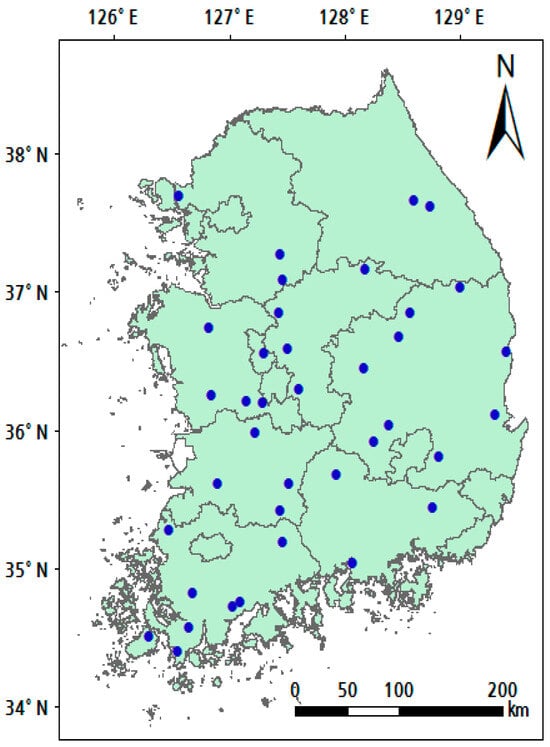
Figure 1.
Map of South Korea showing the distribution of the RDA soil moisture measurement stations in blue dots.
The input variables for retrieving soil moisture were selected based on the factors influencing surface hydrology, such as NDVI, FPAR, precipitation, soil type, soil temperature, slope, and elevation. Data for these variables from March to November for the years 2013 to 2019 are summarized in Table 1. The NDVI and FPAR data, which serve as the indicators of vegetation vitality and photosynthesis, were obtained from the Aqua MODIS. The MODIS instrument, operated by NASA for Earth environmental monitoring, is onboard the Terra and Aqua satellites, both of which have sun-synchronous orbits. These satellites pass over specific locations at the same local time each day. Terra crosses the equator from north to south (descending path) at approximately 10:30 a.m. local time, while Aqua crosses the equator from south to north (ascending path) at approximately 1:30 p.m. local time.

Table 1.
The data used for this study.
The GPM mission is an international satellite network that provides global observations of rain and snow []. For this study, we used the TRMM_3B42_Daily version 7 product, which offers improved rainfall estimates with significantly lower bias over complex topography compared to previous versions []. Precipitation acts as a water supply to the land surface, where it can be absorbed by soil, evaporated, or transpired by vegetation. In addition to short-term precipitation over one, two, or three days, cumulative precipitation over a few months is also closely associated with soil moisture. Therefore, we used the standardized precipitation index 3 (SPI3) to represent the degree of recent three-month precipitation alongside short-term precipitation. SPI3 is calculated using the z-score of the empirical cumulative distribution function (ECDF) of the three-month accumulated precipitation.
where is the ECDF of the i-th day; is the mean of the entire ECDF; and is the standard deviation of the ECDF.
LDAPS is the numerical weather prediction model operated by KMA, a localized version of the Unified Model (UM) developed by the United Kingdom’s Meteorological Office (MetOffice). KMA provides 3-hourly weather forecast data on a 1.5 km grid using three-dimensional variational data assimilation (3DVAR), which is optimized for physical processes such as radiation, boundary layers, convection, and land surfaces []. For this study, we extracted soil temperature data for the 0.0–0.1 m depth below ground (Tsoil10) at noon local time, covering the period from 2013 to 2019. The SRTM is a global terrain observation mission conducted in collaboration between NASA’s Jet Propulsion Laboratory (JPL) and the National Geospatial-Intelligence Agency (NGA). The SRTM DEM covers approximately 80% of the Earth’s surface between 60° N and 56° S, with a spatial resolution of about 90 m (3 arc-seconds) []. For this study, we utilized the elevation and slope data derived from the SRTM DEM. Soil type is determined by the sand–silt–clay ratio (Figure 2). According to the HWSD classification, South Korea predominantly has six soil types: sandy clay loam, clay loam, sandy loam, loam, silt loam, and sandy clay.
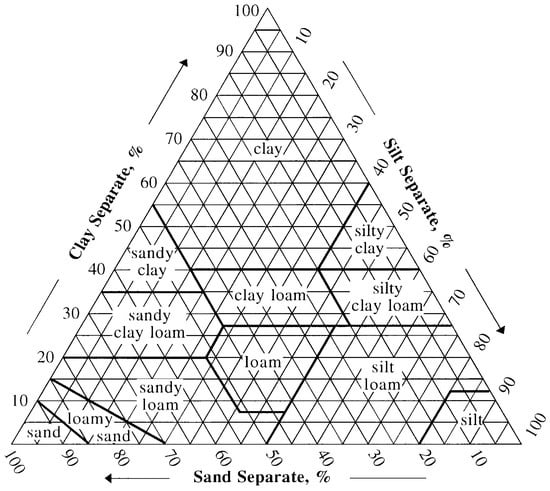
Figure 2.
Soil type according to sand–silt–clay ratio (https://www.usda.gov/, accessed on 20 August 2024).
To extract croplands in South Korea, we used the MODIS land cover-type product (MCD12Q1). This product is generated through supervised classification using the reflectance of multiple spectral bands and is updated annually on a 500 m grid []. Following the classification criteria of the International Geosphere–Biosphere Programme (IGBP), we extracted the pixels classified as croplands, specifically categories 12 (croplands) and 14 (cropland/natural vegetation mosaic). To ensure consistency across the different datasets, we constructed a daily database with 500 m resolution through a resampling process.
3. Methods
3.1. Machine Learning Modeling
RF is an ensemble method that utilizes bootstrap and bagging techniques []. It generates multiple decision trees with slightly different features by repeatedly extracting random samples from the training data, incorporating a bootstrap process to assess the suitability of the sampling distribution and perform resampling as needed (Figure 3). During the bagging process, these bootstrap-based decision trees are aggregated to create a final decision through ensemble methods such as averaging or majority voting. The optimal size of the trees can be determined using a tree pruning algorithm. In our experiment, the number of trees was set to 50, and the number of variables used for splitting nodes was set to n/3 (where n is the number of input variables). Additionally, the out-of-bag error was used as the criterion for model suitability.
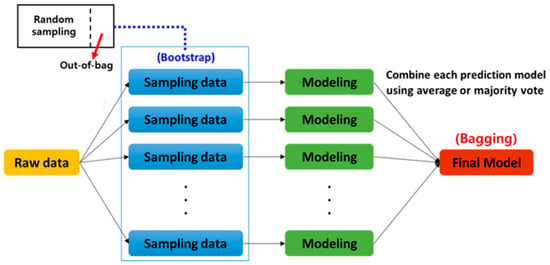
Figure 3.
Modeling outline of random forest model.
AutoML was designed to reduce the time-consuming efforts involved in model optimization during the model-building process. It automates the construction of a machine learning pipeline within a limited computational budget [,]. AutoML automates the process of setting and optimizing various hyperparameters across multiple models, such as RF, Gradient Boosting Machine (GBM), and Deep Neural Network (DNN). Multiple models selected from the leaderboard can be combined into an ensemble model for improved performance [,]. In this experiment, we ran 20 different AI models, including RF, GBM, and DNN, and derived two types of ensembles: (1) a stacked ensemble of all 20 models and (2) a stacked ensemble of the best-performing models from RF, GBM, and DNN, respectively. The better-performing ensemble from these two was then selected. We used the h2o library in R 3.44.0.3 for model building. Figure 4 displays the key code implementations for the RF and AutoML models using the h2o library in R 3.44.0.3.
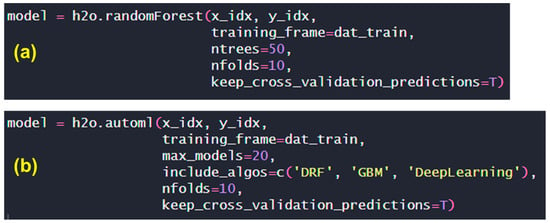
Figure 4.
Key code implementations for the (a) RF and (b) AutoML models using the h2o library in R 3.44.0.3.
3.2. Training and Blind Test
A calibration/validation process is typically employed to optimize statistical models, where model parameters are adjusted using a training dataset extracted from the entire database, and the remaining data are used for a blind test of the optimized model. In this study, the 62,645 datasets were divided into 80% (49,981 records) for training and 20% (12,664 records) for blind testing. The number of training and test datasets was adjusted to be identical for each month to ensure temporally unbiased sampling. The training process included a 10-fold cross-validation to select the best model for the experiment. Then, a blind test was conducted using the optimized model and the remaining unseen datasets. We evaluated the model’s performance using accuracy statistics such as mean bias error (MBE), mean absolute error (MAE), root mean square error (RMSE), and correlation coefficient (CC).
4. Result and Discussion
4.1. Retrieval of Daily Soil Moisture
For building the AutoML model, 20 different models were generated, including 3 RF, 10 GBM, and 7 DNN models, according to the preliminary evaluation by the h2o library. Then, we compared the stacked ensembles from all the models and from the best models for each family. In this experiment, the former one showed better performance than the latter one. Table 2 presents the result of the blind tests for RF and AutoML. The MBE for the two optimized models were −0.015% for RF and 0.031% for AutoML, respectively. Both models had almost zero bias when considering that the actual range of soil moisture in South Korea was between 5% and 60%, with an average of 30%. The RF model showed an MAE of 2.351%, an RMSE of 3.339%, and a CC of 0.913, and the AutoML model showed an MAE of 1.855%, an RMSE of 2.713%, and a CC of 0.940. Figure 5 presents the scatter plots comparing the soil moisture content retrieved using the RF and AutoML models against the RDA soil moisture content. The results show that both models are closely aligned with the one-to-one line, indicating a strong level of agreement.

Table 2.
Accuracy comparison of the RF and AutoML models.
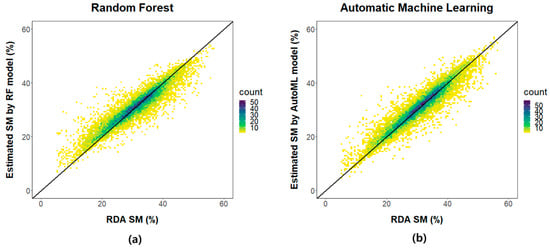
Figure 5.
Scatterplots for the RDA in situ daily SM vs. estimated daily SM in the blind test of the (a) RF and (b) AutoML models in the croplands of South Korea, 2013–2019.
To assess the importance of the ten input features (NDVI, FPAR, SPI3, 1-/2-/3-day precipitation, soil temperature, elevation, slope, and soil type) in retrieving daily soil moisture, the permutation feature importance (PFI) was calculated, as shown in Table 3. SPI3, a meteorological drought index representing the degree of precipitation compared to normal years, had the highest importance at 17.44%. Additionally, the 1-day, 2-day, and 3-day accumulated precipitation accounted for a combined importance of 13.23%. This suggests a strong relationship between soil moisture and precipitation, indicating that both long-term (SPI3) and short-term (1/2/3-day) precipitation significantly influence the daily soil moisture in South Korea. The terrain factors such as slope and elevation also showed considerable importance (15.58% and 13.78%, respectively), reflecting the role of runoff mechanisms, where water moves from higher to lower elevations due to gravity. The vegetation variables such as NDVI and FPAR were also highly important (14.38% and 10.01%, respectively), as the evaporation and transpiration rates can differ significantly between vegetated and bare soil. High soil temperature can increase the evaporation rate from the soil surface, leading to a reduction in soil moisture, and vice versa. Soil type, defined by the sand–silt–clay ratio, affects the processes of water infiltration and retention.

Table 3.
The importance of the RF model’s input variables in the croplands of South Korea, 2013–2019.
4.2. Characteristics of the Validation Statistics by Period
To conduct a more detailed analysis of the soil moisture retrieval results, the accuracy statistics were examined by year and month. This approach provided a comprehensive understanding of the accuracy characteristics, offering insights into the variability and trends in soil moisture over time. The validation statistics for soil moisture retrieved by the RF and AutoML models were evaluated annually, as shown in Table 4. In terms of MBE, the RF model exhibited a bias ranging from −0.841 to 1.221, with an average of 0.035, while the AutoML model showed a bias ranging from −0.327 to 0.658, with an average of 0.053. Although both models demonstrated similar MBE, the AutoML model performed slightly better. The RF model recorded an MAE ranging from 1.883% to 2.300%, RMSE ranging from 2.645% to 3.347%, and CC ranging from 0.902 to 0.938. The AutoML models exhibited even higher accuracy, with MAE ranging from 1.728% to 1.978%, RMSE ranging from 2.519% to 2.827%, and CC ranging from 0.910 to 0.955. The comparative analysis of the two models’ retrieval accuracy revealed that AutoML consistently outperformed RF in retrieving soil moisture on a yearly basis. Figure 6 and Figure 7 present the scatterplots comparing the RDA soil moisture with the soil moisture retrieved by RF and AutoML according to year. These plots indicate that both models produced consistent yearly results, highlighting their stability and reliability.

Table 4.
Soil moisture retrieval accuracy of the RF and AutoML model in the croplands in South Korea according to year.
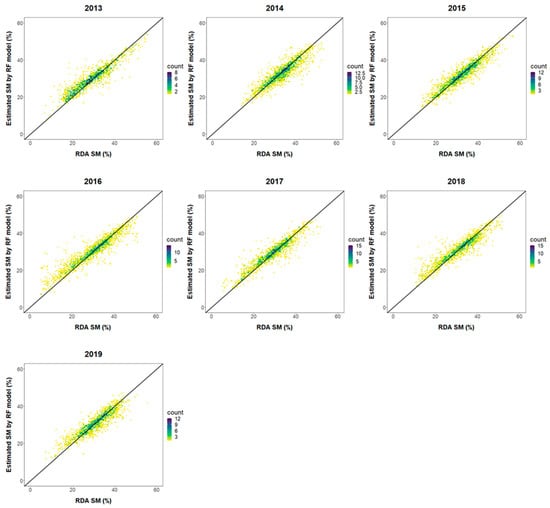
Figure 6.
Scatterplots for the observed vs. estimated daily SM in the blind test of the RF models in the croplands of South Korea according to year.
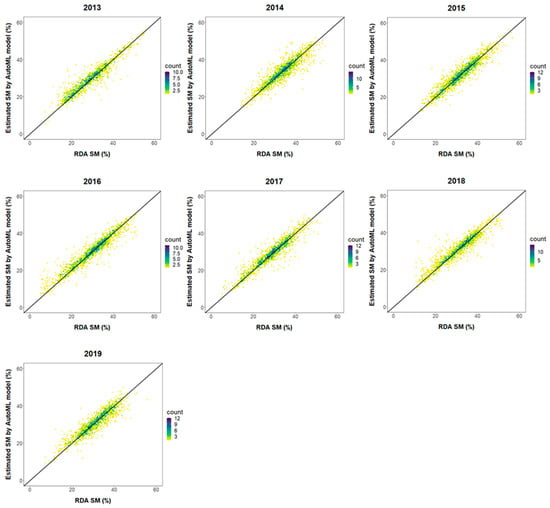
Figure 7.
Scatterplots for the observed vs. estimated daily SM in the blind test of the AutoML models in the croplands of South Korea according to year.
We then conducted a monthly analysis of the soil moisture retrieval accuracy for March and November, as presented in Table 5. The results revealed that the RF model exhibited an MAE ranging from 1.533% to 3.248%, an RMSE ranging from 2.241% to 4.372%, and a CC between 0.868 and 0.957. In comparison, the AutoML model demonstrated better accuracy, with an MAE range of 1.155% to 2.553%, an RMSE ranging from 1.725% to 3.530%, and a CC between 0.904 and 0.969. When comparing the accuracy of the retrievals between the RF and AutoML models, AutoML consistently showed higher monthly accuracy. Specifically, AutoML exhibited a CC greater than 0.9 for all the monthly calculations, whereas RF displayed lower CC values of 0.875 and 0.868 in June and July, respectively. The analysis of both the RF and AutoML models also indicated that the RMSE values from June to August were consistently higher than 3%, exceeding the levels observed in other months. This is likely associated with the unique precipitation patterns observed in South Korea during this period. The total annual precipitation in South Korea ranges from 1200 mm to 1500 mm in the central regions and from 1000 mm to 1800 mm in the southern regions. Notably, approximately 63% of the total annual rainfall is concentrated during the summer months (June, July, and August). During this period, a distinct meteorological phenomenon known as Changma, part of the summer Asian monsoon system, typically begins at the end of June and lasts for about a month. This period is characterized by a higher frequency of heavy rainfall and flooding events in the region. Additionally, South Korea experiences concentrated precipitation during the summer, with an average of two or three typhoons occurring between June and October. Due to these conditions, the soil moisture calculation accuracy during this period is often affected by cloud cover and flooding, leading to lower levels of precision. Despite these unique precipitation characteristics, the analysis revealed that the AutoML model demonstrated a stable soil moisture retrieval accuracy, maintaining a CC of 0.9 or greater each month. Figure 8 and Figure 9 depict the retrieved scatter plots for the RF and AutoML models. Notably, from June to August, the scatter plots for both models showed wider dispersion along the one-to-one line compared to the other months. However, it was observed that the results obtained by AutoML were more closely aligned with the one-to-one line than those obtained by RF, indicating higher precision.

Table 5.
Soil moisture retrieval accuracy of the RF and AutoML models in the croplands in South Korea according to month.
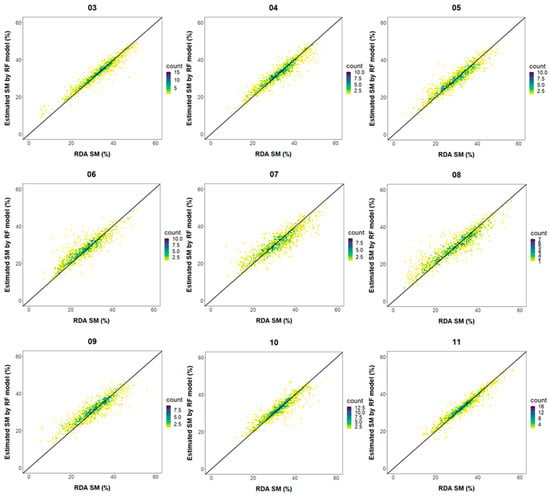
Figure 8.
Scatterplots for the observed vs. retrieved daily SM in the blind test of the RF model in the croplands of South Korea according to month.
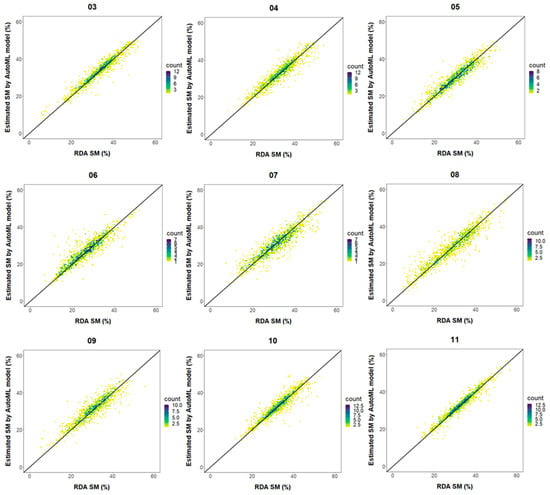
Figure 9.
Scatterplots for the observed vs. retrieved daily SM in the blind test of the AutoML model in the croplands of South Korea according to month.
4.3. Agrometeorological Characteristics
Figure 10a illustrates the annual and monthly variations in the RDA soil moisture content. Figure 10b,c show the yearly and monthly changes in soil moisture as estimated by the RF and AutoML models, respectively. The soil moisture levels in August 2014 (the maximum value during the study period), June 2017 (the minimum value during the study period), and August 2016 (another minimum value during the study period) were notably different from those observed in the other years. Therefore, a more detailed examination of the meteorological characteristics during these periods was conducted.
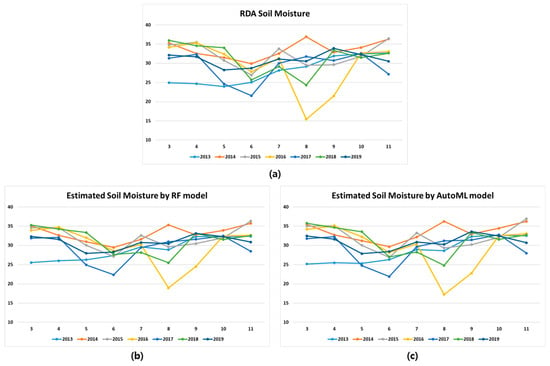
Figure 10.
Time-series charts of the monthly soil moisture content for (a) RDA, (b) RF, and (c) AutoML in the croplands of South Korea, 2013–2019.
In August 2014, the soil moisture levels were the highest compared to the corresponding month in the other years (Figure 10a). Upon examining the meteorological conditions during this period, it was found that the region experienced two typhoons and frequent episodes of localized heavy rainfall, resulting in precipitation levels approximately 138% higher than the average year. This substantial increase in precipitation likely contributed to the elevated soil moisture levels observed. During this period, the in situ soil moisture content was recorded at 36.91%, while the RF and AutoML model estimates were 35.33% and 36.25%, respectively (Figure 11). The AutoML model produced an estimate closer to the actual value than the RF model. Figure 12 illustrates the NDVI, FPAR, SPI3, and soil temperature (Tsoil10) used in the AutoML model, as well as the surface temperature (Ts) and air temperature (Ta) values for August, obtained from LDAPS, which were not used in the model. The red rectangle highlighted shows that the SPI3 in 2014 was relatively higher than in the other years. Additionally, the three temperature variables (Tsoil10, Ts, and Ta) exhibited lower values compared to the other years. Based on the variables presented in Figure 12, it can be inferred that 2014 experienced higher precipitation and lower temperatures than the other years, leading to a reduced rate of moisture evaporation. These meteorological conditions likely contributed to the high soil moisture levels observed in August 2014.
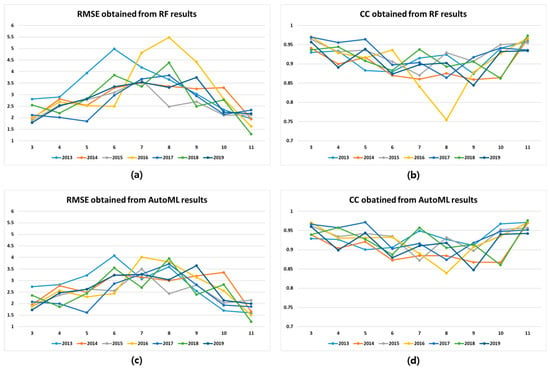
Figure 11.
Time-series charts of the RMSE and CC for monthly soil moisture in the croplands of South Korea, 2013–2019: (a) RMSE of RF, (b) CC of RF, (c) RMSE of AutoML, and (d) CC of AutoML.
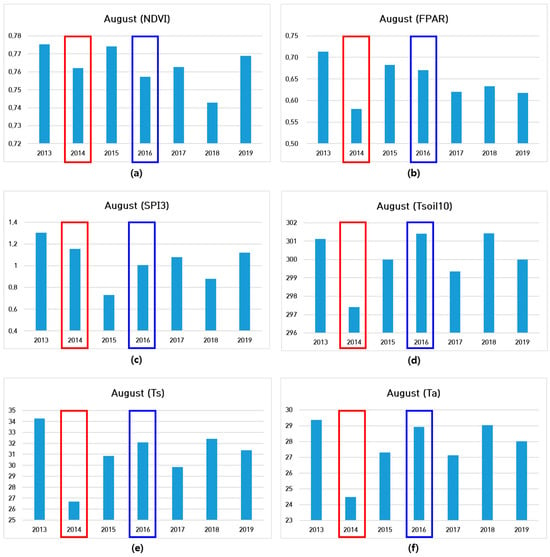
Figure 12.
The bar charts for (a) NDVI, (b) FPAR, (c) SPI3, (d) Tsoil10, (e) Ts, and (f) Ta in August during 2013–2019 in the croplands of South Korea. Precipitation was higher in 2014 (red box), while temperature was higher in 2016 (blue box).
In June 2017, a significant temperature fluctuation was observed (Max Ta 31.6 °C, Min Ta 12.5 °C/Max Ts 38.2 °C, Min Ts 11.5 °C), and the precipitation levels were substantially lower, at about 38% of the average year. These meteorological conditions led to a drought in the study area. During this time, the actual soil moisture content was recorded at 21.560%, while the RF and AutoML models retrieved values of 22.371% and 21.908%, respectively, with AutoML providing a closer estimate. By examining the values of the variables in the red rectangle in Figure 13, it is evident that SPI3 showed the lowest negative value compared to the same period in the other years. This indicates that the study area received minimal precipitation in the preceding three months, ultimately leading to the drought in June. Furthermore, while the three temperature variables showed lower or similar values compared to the average year, there was a significant temperature change between the beginning and end of June, as reported by the KMA. Due to the drought and temperature fluctuations, the soil moisture levels were low, resulting in decreased NDVI values compared to an average year, as shown in Figure 13.
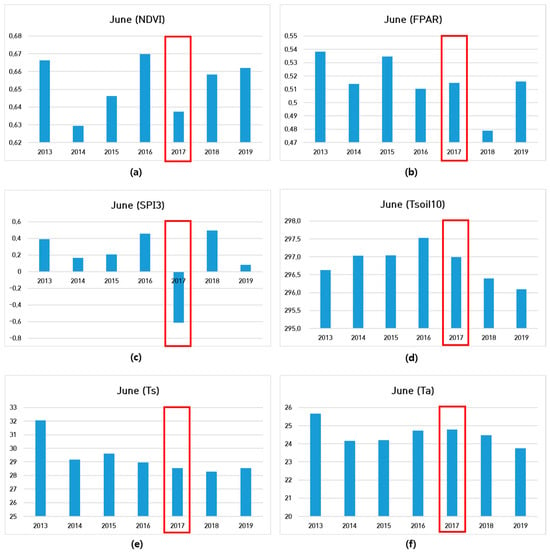
Figure 13.
The bar charts for (a) NDVI, (b) FPAR, (c) SPI3, (d) Tsoil10, (e) Ts, and (f) Ta in June during 2013–2019 in the croplands of South Korea. Precipitation was lower than usual, but the temperature was moderate in 2017 (red box).
In August 2016, South Korea experienced the highest number of heatwave days on record (20 days), leading to a rapid decrease in the actual soil moisture levels to 15.459% (Figure 10a). Tsoil10, Ts, and Ta demonstrated higher values compared to the other years within the study period, with particularly high soil temperatures. The retrieved soil moisture values from the RF (Figure 10b) and AutoML (Figure 10c) models were 18.958% and 17.249%, respectively, confirming that the AutoML estimate was closer to the actual value. Figure 11 presents the RMSE and CC for RF and AutoML, corresponding to the results shown in Figure 10. The RMSE values for both models were relatively high during the summer, while the CC values were relatively low, indicating a slightly higher error in estimating soil moisture than in the other seasons. For the RF model, the RMSE by month varied between 2.241% and 4.372%, with a CC ranging from 0.868 to 0.957. For the AutoML model, the RMSE by month ranged from 1.725% to 3.530%, and the CC ranged from 0.904 to 0.969. These results suggest that the AutoML model performs more consistently and accurately in estimating soil moisture throughout the year, as evidenced by its narrower range of variation in RMSE and CC. During August 2016, when the soil moisture levels were exceptionally low due to a heatwave and drought, the RF model displayed a high RMSE value (Figure 11a). In contrast, the AutoML model exhibited relatively lower errors (Figure 11c). However, the CC for RF was lower during this period compared to the other times (Figure 11b), whereas AutoML maintained a more stable correlation (Figure 11d).
The results of the study confirm that the changes in precipitation, drought, and heatwaves directly impact the soil moisture content (Figure 12 and Figure 13). Moreover, the AutoML ensemble model successfully captured the trend in soil moisture variation in a manner closely aligned with the actual values even under extreme weather conditions. These findings highlight the potential of AutoML models in accurately estimating soil moisture and their resilience in coping with the impacts of extreme weather events. Figure 14, Figure 15, Figure 16 and Figure 17 show the soil moisture maps created by the AutoML model.
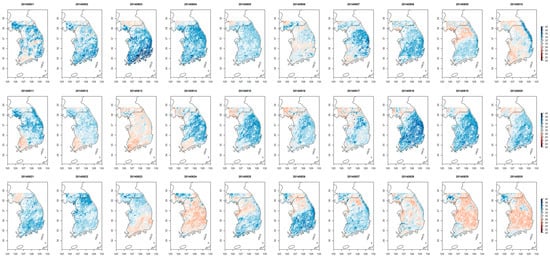
Figure 14.
Soil moisture maps of South Korea in August 2014 with more precipitation than other years.
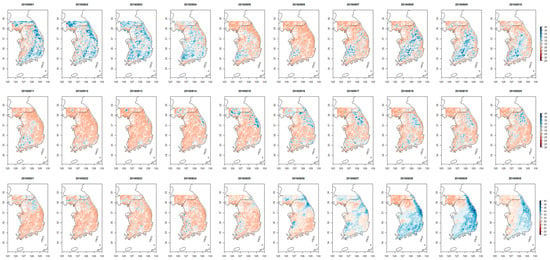
Figure 15.
Soil moisture maps of South Korea in August 2016 with more heatwaves than other years.
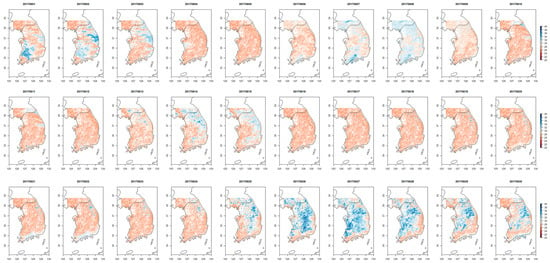
Figure 16.
Soil moisture maps of South Korea in June 2017 with less precipitation than other years.
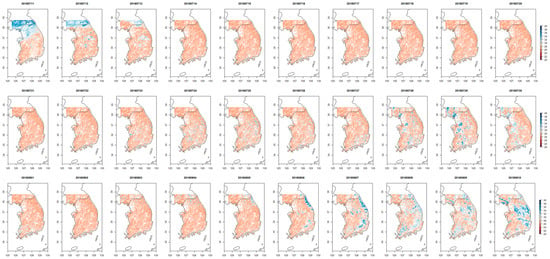
Figure 17.
Soil moisture maps of South Korea in July and August 2018 with record-breaking heatwaves.
4.4. Comparison with Other Soil Moisture Data
To verify that the soil moisture values retrieved in this study have been regionally optimized for South Korea, a comparative analysis was conducted with various soil moisture products, including ESA CCI, GLDAS, LDAPS, and ERA5 (Table 6). The ESA CCI SM v05.2 product is based on both active (e.g., ERS-1/2 Scatterometer and METOP Advanced Scatterometers) and passive (e.g., SMMR, SSM/I, TMI, AMSR-E, Windsat, AMSR2, SMOS, and SMAP) microwave observations []. The depth of the soil layer varies depending on the sensors, but the daily topsoil moisture information (approximately 0 to 5 cm) is provided at a resolution of 0.25° (https://www.esa-soilmoisture-cci.org/, accessed on 20 August 2024). For this study, we obtained the Level 3 COMBINED daily soil moisture product. GLDAS is a reliable assimilation system that integrates a vast number of in situ observations with multiple land surface models (LSMs) such as Mosaic [], Variable Infiltration Capacity (VIC) [], Noah [], and the Community Land Model (CLM) [,,]. We used GLDAS Noah V2.1 and extracted the soil moisture variable for the topsoil layer (0 to 10 cm) at 3 h intervals with a resolution of 0.25° (https://developers.google.com/earth-engine/datasets/catalog/NASA_GLDAS_V021_NOAH_G025_T3H, accessed on 20 August 2024). LDAPS is based on the Unified Model (UM) designed by the UK MetOffice, and we obtained the LDAPS soil moisture data at a 10 cm depth. ERA5 is a state-of-the-art reanalysis produced by ECMWF, following its predecessor, ERA-Interim []. We collected hourly reanalysis data at the surface level, including volumetric soil water at a resolution of 0.25°, and extracted the topsoil layer (0 to 7 cm) variable from the Climate Data Store (CDS) of the Copernicus Climate Change Service (https://cds.climate.copernicus.eu/, accessed on 20 August 2024). Due to the differences in the spatiotemporal resolution between the datasets, we aggregated the temporal resolution of the datasets to a daily scale. We aligned the spatial resolution by matching the pixel value closest to the central latitude and longitude using Euclidean distance. We then compared the RDA in situ soil moisture with our AutoML-based soil moisture and the other operative soil moisture data (Table 7).

Table 6.
Summary of operative soil moisture data used in this study.

Table 7.
Comparison of the accuracy of the soil moisture contents from AutoML, ESA CCI, GLDAS, LDAPS, and ERA5 in the croplands in South Korea, 2013–2019.
The analysis revealed that our AutoML model achieved higher accuracy, with an RMSE of 2.713% and a CC of 0.940. In contrast, the four other soil moisture datasets showed relatively lower accuracy, with the RMSE values ranging from 7.826% to 9.900% and CC values ranging from 0.257 to 0.306. Figure 18 presents a scatter plot comparing the results with the RDA soil moisture. The soil moisture data from our AutoML model (Figure 18a) showed a strong, concentrated relationship with the RDA soil moisture. However, the soil moisture contents from ESA CCI, GLDAS, LDAPS, and ERA5 were more widely dispersed, making it difficult to establish a strong correlation with the RDA soil moisture. This discrepancy is likely due to the coarse spatial resolution and uncertainties of the land surface models. South Korea’s complex topography and diverse land cover within a relatively small area make it challenging to accurately calculate the soil moisture content using low-resolution data. Additionally, since the datasets from ESA CCI, GLDAS, LDAPS, and ERA5 are algorithmically based on regions like the United States and Europe, they may not accurately represent the soil moisture content in South Korea.
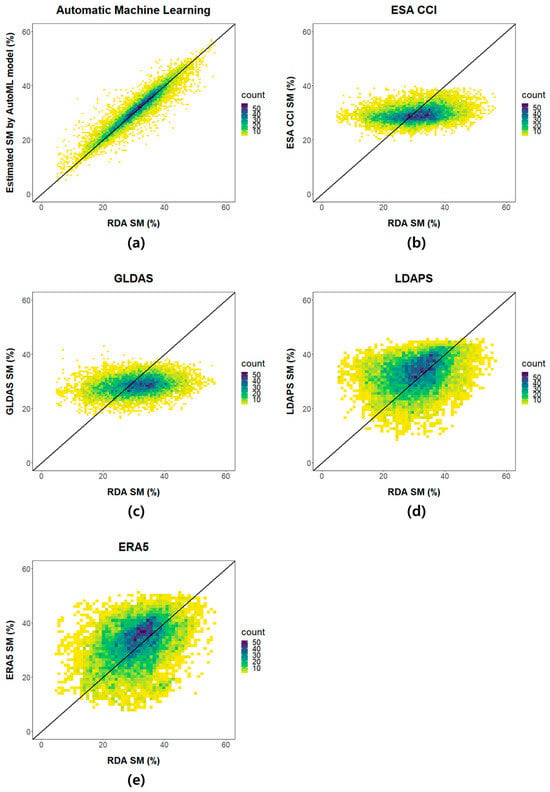
Figure 18.
Scatter plots for the observed vs. (a) AutoML, (b) ESA CCI, (c) GLDAS, (d) LDPAS, and (e) ERA5 daily soil moisture in the croplands of South Korea, 2013–2019.
5. Conclusions
This paper presents the development of an AI model for retrieving soil moisture in croplands across South Korea utilizing satellite images, meteorological data, and DEM. The RF model was optimized for soil moisture retrieval, and AutoML was employed to create an ensemble of multiple AI models. In a blind test conducted over the period 2013–2019, the AutoML model produced more accurate results, with an RMSE of 2.713% and a CC of 0.940, indicating a stronger relationship between the retrieved and observed values. The blind test results were analyzed by year and month. The yearly analysis revealed that both models consistently retrieved soil moisture across all the years, with AutoML demonstrating slightly higher accuracy. The monthly analysis showed that the AutoML model maintained high accuracy throughout the year, with a correlation coefficient of 0.9 or higher even during the summer months, which are characterized by concentrated precipitation in South Korea.
To better understand the performance of the models during periods of rapid soil moisture change due to heatwaves or drought, the study examined the meteorological characteristics of these periods. The analysis revealed that our AutoML model was able to retrieve soil moisture values closely aligned with the actual measurements even during extreme weather events. These results demonstrate that soil moisture content can be retrieved with higher accuracy using an ensemble model that leverages the strengths of multiple models rather than relying on a single model. Additionally, a comparative analysis with various operational soil moisture datasets from the reanalysis data highlighted their limitations over the complex terrain in South Korea when compared to in situ measurements. Our AutoML model achieved the highest accuracy, confirming that the proposed approach is a feasible method for soil moisture mapping in South Korea. In this study, AutoML was applied to 62,645 records with one target variable and ten input features. Training the AutoML model with 20 ensemble members took less than an hour on a standard PC with an Intel i9 CPU, which is quite cost-effective given the benefits that AutoML provides.
Our novel approach demonstrates the feasibility of applying machine learning techniques to produce daily soil moisture sing satellite data and other auxiliary data from South Korea. Our target was near-surface soil moisture due to limitations in the input data. In future studies, modeling soil moisture at deeper layers should be investigated to meet the demands of the other sectors. Additionally, increasing the amount of the input data would likely further improve the model’s accuracy, which is characteristic of data-driven models.
Author Contributions
Conceptualization, N.K. and Y.L.; methodology, N.K. and Y.L.; data curation, N.K.; writing—original draft preparation, N.K.; writing—review and editing, N.K., S.-J.L., E.S., M.K., S.S., S.H.K. and Y.L. All authors have read and agreed to the published version of the manuscript.
Funding
This research was supported by the R&D Program of the Korea Meteorological Administration (KMA2020-00120). This work was supported by the National Research Foundation of Korea (NRF) grant funded by the Korean government (MSIT) (No. 2021R1F1A1062467). This work was supported by Korea Environment Industry & Technology Institute (KEITI) through the Project “Developing an Observation-based GHG Emissions Geospatial Information Map” funded by Korea Ministry of Environment (MOE) (RS-2023-00232066).
Data Availability Statement
The original data presented in the study are openly available in https://nmsc.kma.go.kr/.
Conflicts of Interest
The authors declare no conflicts of interest.
References
- Wagner, W.; Lemoine, G.; Rott, H. A method for estimating soil Moisture from ERS scatterometer and soil data. Remote Sens. Environ. 1999, 70, 191–207. [Google Scholar] [CrossRef]
- Jat, M.L.; Singh, B.; Stirling, C.M.; Jat, H.S.; Tetarwal, J.P.; Jat, R.K.; Singh, R.; Lopez-Ridaura, S.; Shirsath, P.B. Soil processes and wheat cropping under emerging climate change scenarios in South Asia. In Advances in Agronomy; Academic Press: New York, NY, USA, 2018; Volume 148, pp. 111–171. [Google Scholar]
- Schmugge, T.; Jackson, T.; McKim, H. Survey of methods for soil moisture determination. Water Resour. Res. 1980, 16, 961–979. [Google Scholar] [CrossRef]
- Grayson, R.B.; Western, A.W. Toward areal estimation of soil water content from point measurements: Time and space stability of mean response. J. Hydrol. 1998, 207, 68–82. [Google Scholar] [CrossRef]
- Benninga, H.J.F.; Carranza, C.D.U.; Pezij, M.; van Santen, P.; van der Ploeg, M.J.; Augustijn, D.C.M.; van der Velde, R. Regional soil moisture monitoring network in the Raam catchment in the Netherlands. Earth Syst. Sci. Data Discuss. 2017, 2017, 1–31. [Google Scholar]
- Gill, M.K.; Asefa, T.; Kemblowski, M.W.; McKee, M. Soil moisture prediction using support vector machines. JAWRA J. Am. Water Resour. Assoc. 2006, 42, 1033–1046. [Google Scholar] [CrossRef]
- Jiang, H.; Cotton, W.R. Soil moisture estimation using an artificial neural network: A feasibility study. Can. J. Remote Sens. 2004, 30, 827–839. [Google Scholar] [CrossRef]
- Chai, S.S.; Walker, J.P.; Makarynskyy, O.; Kuhn, M.; Veenendaal, B.; West, G. Use of soil moisture variability in artificial neural network retrieval of soil moisture. Remote Sens. 2009, 2, 166–190. [Google Scholar] [CrossRef]
- Ahmad, S.; Kalra, A.; Stephen, H. Estimating soil moisture using remote sensing data: A machine learning approach. Adv. Water Resour. 2010, 33, 69–80. [Google Scholar] [CrossRef]
- Hassan-Esfahani, L.; Torres-Rua, A.; Jensen, A.; McKee, M. Assessment of surface soil moisture using high-resolution multi-spectral imagery and artificial neural networks. Remote Sens. 2015, 7, 2627–2646. [Google Scholar] [CrossRef]
- Hutter, F.; Kotthoff, L.; Vanschoren, J. Automated Machine Learning: Methods, Systems, Challenges; Springer Nature: Berlin/Heidelberg, Germany, 2019. [Google Scholar]
- He, X.; Zhao, K.; Chu, X. AutoML: A survey of the state-of-the-art. Knowl.-Based Syst. 2021, 212, 106622. [Google Scholar] [CrossRef]
- Khan, M.A.; Iqbal, N.; Jamil, H.; Kim., D.H. An optimized ensemble prediction model using AutoML based on soft voting classifier for network intrusion detection. J. Netw. Comput. Appl. 2023, 212, 103560. [Google Scholar] [CrossRef]
- Huffman, G.J.; Adler, R.F.; Bolvin, D.T.; Nelkin, E.J. The TRMM multi-satellite precipitation analysis (TMPA). In Satellite Rainfall Applications for Surface Hydrology; Springer: Berlin/Heidelberg, Germany, 2010; pp. 3–22. [Google Scholar]
- Zulkafli, Z.; Buytaert, W.; Onof, C.; Manz, B.; Tarnavsky, E.; Lavado, W.; Guyot, J.L. A comparative performance analysis of TRMM 3B42 (TMPA) versions 6 and 7 for hydrological applications over Andean–Amazon River basins. J. Hydrometeorol. 2014, 15, 581–592. [Google Scholar] [CrossRef]
- Kim, D.; Kang, G.; Kim, D.; Kim, J. Characteristics of LDAPS-predicted surface wind speed and temperature at automated weather stations with different surrounding land cover and topography in Korea. Atmosphere 2020, 11, 1224. [Google Scholar] [CrossRef]
- Werner, M. Shuttle radar topography mission (SRTM) mission overview. Frequenz 2001, 55, 75–79. [Google Scholar] [CrossRef]
- Sulla-Menashe, D.; Friedl, M.A. User Guide to Collection 6 MODIS Land Cover (MCD12Q1 and MCD12C1) Product. Available online: https://lpdaac.usgs.gov/documents/101/MCD12_User_Guide_V6.pdf (accessed on 7 July 2023).
- Breiman, L. Random forests. Mach. Learn. 2001, 45, 5–32. [Google Scholar] [CrossRef]
- Yao, Q.; Wang, M.; Chen, Y.; Dai, W.; Yi-Qi, H.; Yu-Feng, L.; Wei-Wei, T.; Qiang, Y.; Yang, Y. Taking human out of learning applications: A survey on automated machine learning. arXiv 2018, arXiv:1810.13306. [Google Scholar]
- Zoller, M.; Huber, M.F. Benchmark and survey of automated machine learning frameworks. J. Artif. Intell. Res. 2019, 70, 409–472. [Google Scholar] [CrossRef]
- Belgiu, M.; Drăgu¸t, L. Random Forest in remote sensing: A review of applications and future directions. ISPRS J. Photogramm. Remote Sens. 2016, 114, 24–31. [Google Scholar] [CrossRef]
- Pasik, A.; Scanlon, T.; Dorigo, W.; de Jeu, R.A.M.; Hahn, S.; van der Schalie, R.; Wagner, W.; Kidd, R.; Gruber, A.; Moesinger, L.; et al. ESA Climate Change Initiative Plus—Soil Moisture: Algorithm Theoretical Baseline Document (ATBD) Supporting Product Version v05.2; Earth Observation Data Centre for Water Resources Monitoring (EODC) GmbH: Vienna, Austria, 2020. [Google Scholar]
- Koster, R.D.; Suarez, M.J. Energy and Water Balance Calculations in the Mosaic LSM; National Aeronautics and Space Administration, Goddard Space Flight Center, Laboratory for Atmospheres, Data Assimilation Office: Washington, DC, USA, 1996. [Google Scholar]
- Liang, X.; Lettenmaier, D.P.; Wood, E.F.; Burges, S.J. A simple hydrologically based model of land surface water and energy fluxes for general circulation models. J. Geophys. Res. Atmos. 1994, 99, 14415–14428. [Google Scholar] [CrossRef]
- Ek, M.B.; Mitchell, K.E.; Lin, Y.; Rogers, E.; Grunmann, P.; Koren, V.; Gayno, G.; Tarpley, J.D. Implementation of Noah land surface model advances in the National Centers for Environmental Prediction operational mesoscale Eta model. J. Geophys. Res. Atmos. 2003, 108, 8851. [Google Scholar] [CrossRef]
- Dai, Y.; Zeng, X.; Dickinson, R.E.; Baker, I.; Bonan, G.B.; Bosilovich, M.G.; Denning, A.S.; Dirmeyer, P.A.; Houser, P.R.; Oleson, G.N.K.W.; et al. The Common Land Model. Bull. Am. Meteorol. Soc. 2003, 84, 1013–1024. [Google Scholar] [CrossRef]
- Rodell, M.; Houser, P.R.; Jambor, U.; Gottschalck, J.; Mitchell, K.; Meng, C.-J.; Arsenault, K.; Cosgrove, B.; Radakovich, J.; Bosilovich, M.; et al. The global land data assimilation system. Bull. Am. Meteorol. Soc. 2004, 85, 381–394. [Google Scholar] [CrossRef]
- de Jeu, R.; Holmes, T.; Dorigo, W.; Wagner, W.; Hahn, S.; Parinussa, R. Evaluation of SMOS soil moisture with other existing satellite products. In Proceedings of the Remote Sensing and Hydrology 2010 Symposium, Jackson Hole, WY, USA, 27–30 September 2010; pp. 27–30. [Google Scholar]
- Hersbach, H.; Bell, B.; Berrisford, P.; Hirahara, S.; Horányi, A.; Muñoz Sabater, J.; Nicolas, J.; Peubey, C.; Radu, R.; Schepers, D.; et al. The ERA5 global reanalysis. Q. J. R. Meteorol. Soc. 2020, 146, 1999–2049. [Google Scholar] [CrossRef]
Disclaimer/Publisher’s Note: The statements, opinions and data contained in all publications are solely those of the individual author(s) and contributor(s) and not of MDPI and/or the editor(s). MDPI and/or the editor(s) disclaim responsibility for any injury to people or property resulting from any ideas, methods, instructions or products referred to in the content. |
© 2024 by the authors. Licensee MDPI, Basel, Switzerland. This article is an open access article distributed under the terms and conditions of the Creative Commons Attribution (CC BY) license (https://creativecommons.org/licenses/by/4.0/).